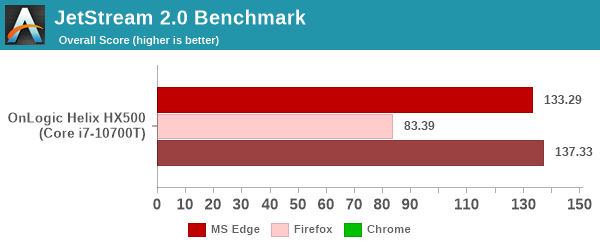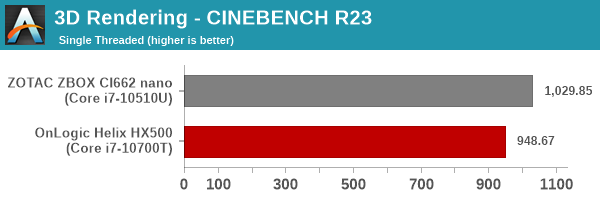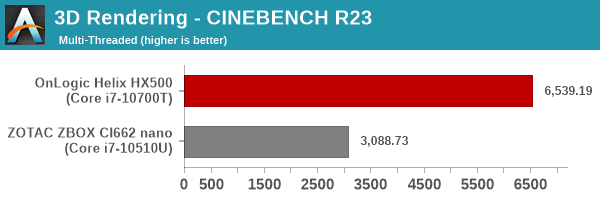The OnLogic Helix HX500 Review: A Rugged Fanless 35W mini-PC
by Ganesh T S on September 17, 2021 10:00 AM EST- Posted in
- Systems
- Intel
- Fanless
- Industrial PC
- Passive Cooling
- Comet Lake
- OnLogic
Performance Metrics
This section looks at some of the other commonly used benchmarks representative of the performance of specific real-world applications.
Web Browser Benchmarks - JetStream and Speedometer
Web browser-based workloads have emerged as a major component of the typical home and business PC usage scenarios. With the advent of JavaScript-based applications, the ability of a processor to handle web browsing workloads has ramifications well beyond just normal browsing, and on to other business and industrial use-cases also. Hosted at BrowserBench, JetStream 2.0 benchmarks JavaScript and WebAssembly performance, while Speedometer measures web application responsiveness. We also process MotionMark, but the confidence level of the results vary as much as +/-35%. Hence, we present only the Jetstream 2.0 and Speedometer results for the three top browsers below.


In order to maintain reproducibility, we self-host the BrowserBench benchmarks (git clone of the WebKit repository as on July 1, 2021). The browser versions used for the numbers above are presented in the table included in each system's review. Since this is a new benchmark in the suite, the tables for all systems presented in the graphs above are given below.
| OnLogic Helix HX500 Browser Bench | |||
| Speedometer 2.0 | JetStream 2.0 | MotionMark 1.2 | |
| Microsoft Edge (92.0.902.55) |
98.5 ± 1.1 | 133.286 | 416.35 ± 32.01% |
| Google Chrome (92.0.4515.107) |
135 ± 1.6 | 137.333 | 715.30 ± 2.81% |
| Mozilla Firefox (90.0.2.7872) |
109.3 ± 1.0 | 83.388 | 478.77 ± 31.71% |
BAPCo's SYSmark 25 and UL's PCMark benchmarks both include web browser activitites as part of their evaluation scheme. However, the performance for this increasingly important workload tends to get lost in the presentation of a single number. JetStream and Speedometer help us focus on how different PC configurations vary in terms of the user experience with respect to web browsers.
3D Rendering - CINEBENCH R23
We use CINEBENCH R23 for 3D rendering evaluation. R23 provides two benchmark modes - single threaded and multi-threaded. Evaluation of different PC configurations in both supported modes provided us the following results.


The Core i7-10710U has a higher turbo of 4.7GHz compared to the 4.5 GHz of the Core i7-10700T. This allows the single-threaded performance of the ZBOX CI662 nano to edge out the HX500. However, the two extra cores and higher power budget allow the HX500 to more than double the performance of the ZBOX CI662 nano in the multi-threaded case.
x265 Benchmark
Next up, we have some video encoding benchmarks using x265 v2.8. The appropriate encoder executable is chosen based on the supported CPU features. In the first case, we encode 600 1080p YUV 4:2:0 frames into a 1080p30 HEVC Main-profile compatible video stream at 1 Mbps and record the average number of frames encoded per second.

Our second test case is 1200 4K YUV 4:2:0 frames getting encoded into a 4Kp60 HEVC Main10-profile video stream at 35 Mbps. The encoding FPS is recorded.

Both of these numbers depend on multi-threaded performance heavily, and it is no surprise that the 8C/16T configuration of the HX500 comes out on top by a huge margin.
7-Zip
7-Zip is a very effective and efficient compression program, often beating out OpenCL accelerated commercial programs in benchmarks even while using just the CPU power. 7-Zip has a benchmarking program that provides tons of details regarding the underlying CPU's efficiency. In this subsection, we are interested in the compression and decompression rates when utilizing all the available threads for the LZMA algorithm.


This is again a test of multi-threaded capabilities and the HX500 comes out on top as expected.
Cryptography Benchmarks
Cryptography has become an indispensable part of our interaction with computing systems. Almost all modern systems have some sort of hardware-acceleration for making cryptographic operations faster and more power efficient. In this sub-section, we look at two different real-world applications that may make use of this acceleration.
BitLocker is a Windows features that encrypts entire disk volumes. While drives that offer encryption capabilities are dealt with using that feature, most legacy systems and external drives have to use the host system implementation. Windows has no direct benchmark for BitLocker. However, we cooked up a BitLocker operation sequence to determine the adeptness of the system at handling BitLocker operations. We start off with a 2.5GB RAM drive in which a 2GB VHD (virtual hard disk) is created. This VHD is then mounted, and BitLocker is enabled on the volume. Once the BitLocker encryption process gets done, BitLocker is disabled. This triggers a decryption process. The times taken to complete the encryption and decryption are recorded. This process is repeated 25 times, and the average of the last 20 iterations is graphed below.


The additional cores and higher power budget ensure that the HX500 has the best numbers in the ecryption / decryption benchmark using BitLocker.
Creation of secure archives is best done through the use of AES-256 as the encryption method while password protecting ZIP files. We re-use the benchmark mode of 7-Zip to determine the AES256-CBC encryption and decryption rates using pure software as well as AES-NI. Note that the 7-Zip benchmark uses a 48KB buffer for this purpose.


The slight edge for the HX500 in pure software processing is complemented by almost double the relative performance when compared to the other fanless systems we have evaluated before.
Yet another cryptography application is secure network communication. OpenSSL can take advantage of the acceleration provided by the host system to make operations faster. It also has a benchmark mode that can use varying buffer sizes. We recorded the processing rate for a 8KB buffer using the hardware-accelerated AES256-CBC-HAC-SHA1 feature.


The numbers of OpenSSL are bunched quite close together, unlike the other cryptography benchmarks. The small workload size may not be providing enough fodder for the HX500 to really flex its capabilities.
Agisoft Photoscan
Agisoft PhotoScan is a commercial program that converts 2D images into 3D point maps, meshes and textures. The program designers sent us a command line version in order to evaluate the efficiency of various systems that go under our review scanner. The command line version has two benchmark modes, one using the CPU and the other using both the CPU and GPU (via OpenCL). We present the results from our evaluation using the CPU mode only. The benchmark (v1.3) takes 84 photographs and does four stages of computation:
- Stage 1: Align Photographs (capable of OpenCL acceleration)
- Stage 2: Build Point Cloud (capable of OpenCL acceleration)
- Stage 3: Build Mesh
- Stage 4: Build Textures
We record the time taken for each stage. Since various elements of the software are single threaded, and others multithreaded, it is interesting to record the effects of CPU generations, speeds, number of cores, and DRAM parameters using this software.




The HX500 comes out as the leader by a huge margin, which is only to be expected given its 8C/16T configuration and 35W TDP, compared to the 4C/8T (28W) and 6C/12T (15W) nature of the other systems in the fray.
Dolphin Emulator
Wrapping up our application benchmark numbers is the new Dolphin Emulator (v5) benchmark mode results. This is again a test of the CPU capabilities.

The 35W TDP allows the HX500 to post the best score among the three systems in the comparison list.










32 Comments
View All Comments
eastcoast_pete - Saturday, September 18, 2021 - link
Does this setup have anything resembling an IPx7 or X8 rating, i.e. is it sealed against water and dust ingress? Those would be among the reasons that might justify the price. Without any such protection, I wonder just how long it'd actually last in an environment that requires a fanless setup.Tomatotech - Saturday, September 18, 2021 - link
I run a K39 PC, which is the smallest cheap PC case on the market & only cost a few dollars from China, not the $1000 this HX500 costs. The K39 contains a standard mITX mobo, flex PSU, and a full size GPU. Works fine. My K39 isn't passively cooled, but if I left out the GPU and put in a low power chip then maybe it could be passively cooled.I also bought in the same package a K19, which is the same form factor as the HX500 (ie no GPU) possibly a little bit smaller and a K29 which is the same form factor as the HX610. Haven't built them yet, but these cases are really tiny, only cost a few dollars, and you can run anything from an iGPU to a full i9 / Ryzen 9 in them.
The cases are all-metal, and being so small, act as part of the radiator for the system. Easy enough to add some fins if needed. Definitely not waterproof or weatherproof but neither is this system.
Arnulf - Sunday, September 19, 2021 - link
"A few dollars" comes out to what, $200 shipped for cheap perforated aluminium box with dodgy PSU, and you are somehow comparing that to a complete PC (motherboard, CPU, RAM, SSD included) with chassis that actually works as a heatsink? Mind boggles ...The_Assimilator - Monday, September 20, 2021 - link
Which part of "The K39 contains a standard mITX mobo" was unclear to you?iammrr - Sunday, January 16, 2022 - link
How to buy this pc?Learn latest technology through whatsapp group-
https://jobingov.com/whatsapp-group-links/
FLORIDAMAN85 - Saturday, September 18, 2021 - link
Oh, look: an $800.00 Raspberry Pi.nandnandnand - Saturday, September 18, 2021 - link
An i7-10700T is somewhere between 5 and 50 times faster.Meteor2 - Sunday, October 3, 2021 - link
The $800 model comes with a CeleronBedfordTim - Monday, September 20, 2021 - link
Not having a 24V power input is disappointing.Wrs - Tuesday, September 21, 2021 - link
Err, the specs page clearly states 12-24v input. The adapter they sell is 20v.